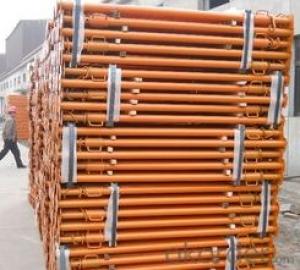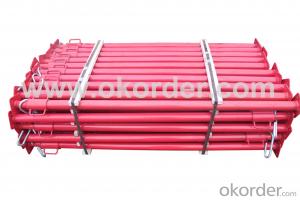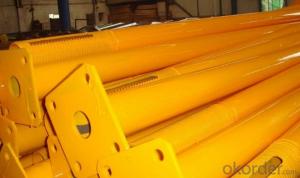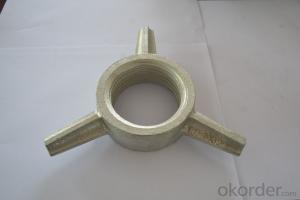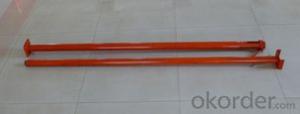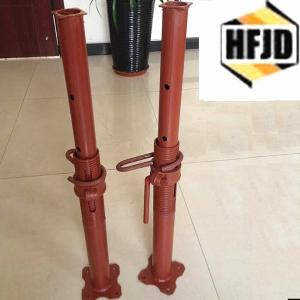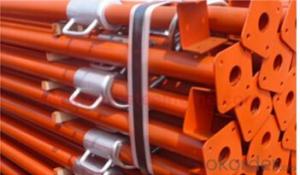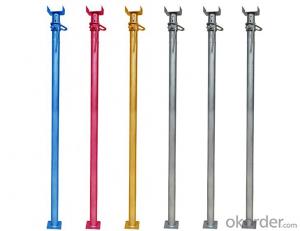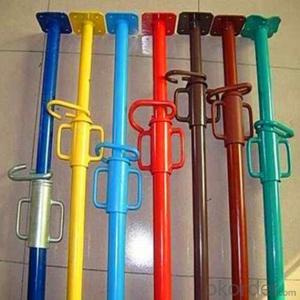Scaffolding System and Accessories
- Loading Port:
- China Main Port
- Payment Terms:
- TT OR LC
- Min Order Qty:
- -
- Supply Capability:
- -
OKorder Service Pledge
OKorder Financial Service
You Might Also Like
Quick Details
| Model Number: | |||||
| Name: | Catagory: | Type: | |||
| Material: | Size: | Surface: | |||
| Technology: | Component: | Application: | |||
| Manufacturer: |
Packaging & Delivery
| Packaging Detail: | as the requirment of clients |
| Delivery Detail: | 20days |
Specifications
RingLock Scaffold System & Accessory
Material: Steel Q235/Q345
Surface:Galvanzied/Painted
Manufacturer, OEM
ISO, BS1139
Name: Q235/Q345 Galvanzied RingLock Scaffold System and Accessories for Construction
Category: Scaffolding system
Material: Steel (Q235/Q345)
Size: D48.3*3.25MM
Surface: Electro Galvanized/Self Color/Painted/HDG
Component: Standard, Ledger, Angle Iron ledger, Diagonal, Bracket, Holder, Support, Edge Banding, Board Holder, base jack, U head Jack, etc.
Application: Slab support,staircase,stage platforms,bridge support,mobile tower etc.
Advantage: Durable, Stable, Skid-proof, Antirust, Easy to assemble & Dismantle
OEM service is available
Items or goods can be manufactured according to your standards
- Q:Can steel props be used in underground construction?
- Yes, steel props can be used in underground construction. Steel props, also known as steel shores or steel acrow props, are adjustable steel tubes used to support vertical loads in construction projects. They are commonly used to support formwork, scaffolding, and other temporary structures in both above-ground and underground construction. In underground construction, steel props can be particularly useful in supporting the excavation process. They are typically used to provide temporary support to tunnels, underground chambers, and other excavated areas. By placing steel props strategically, they can help distribute the load and prevent instability or collapse during the excavation process. Steel props are preferred in underground construction due to their strength, adjustability, and durability. They can withstand heavy loads and can be easily adjusted to the required height, making them versatile for different underground construction projects. Additionally, steel props are resistant to corrosion, which is important in underground environments where moisture and other corrosive elements are more prevalent. In conclusion, steel props can indeed be used in underground construction. They provide crucial support and stability during excavation and are favored for their strength, adjustability, and durability.
- Q:How do you determine the required number of steel props for a project?
- In order to calculate the necessary quantity of steel props for a project, there are several factors that need to be taken into consideration. First and foremost, it is crucial to evaluate the load that the props will be supporting. This involves assessing the weight of the structure or formwork that the props will be utilized to support. The total weight that each prop will bear must be calculated to ensure they have sufficient capacity to safely handle the load. Subsequently, the spacing between the props should be considered. The distance between the props depends on the size and weight of the structure or formwork, as well as the type of props being employed. Generally, for heavier loads or larger structures, the spacing between props should be smaller. The height of the structure or formwork is another essential factor to take into account. The taller the structure, the greater the number of props required to ensure stability and prevent any sagging or deflection. The height-to-base ratio is often used as a means of determining the number of props needed, with higher ratios necessitating more props. Moreover, the type and quality of the props should be factored in. Different props possess varying load capacities, therefore it is vital to review the manufacturer's specifications to ensure that props capable of safely supporting the expected load are being utilized. Finally, it is important to consult any applicable codes or regulations governing the use of props in your region. These regulations may provide specific guidelines or requirements for determining the number of props needed for a particular project. By carefully considering the load, spacing, height, prop type, and relevant regulations, the required number of steel props for a project can be accurately determined. It is always advisable to seek the guidance of a structural engineer or a professional experienced in formwork and scaffolding to guarantee the safety and efficiency of the prop installation.
- Q:What are the common quality control measures for steel props?
- Some common quality control measures for steel props include visual inspection for any visible defects or damage, dimensional checks to ensure proper size and alignment, load testing to determine the weight-bearing capacity, and corrosion resistance testing to assess the durability against rust and corrosion. Additionally, quality control measures may also involve material composition analysis, surface finish inspection, and adherence to industry standards and specifications.
- Q:Can steel props be used for supporting temporary bridges during emergencies?
- Indeed, steel props have the capability to support temporary bridges in emergency scenarios. Their robustness and longevity make them an ideal option for offering provisional assistance to bridges during critical situations. They possess the ability to effectively bear the bridge's weight and guarantee its stability until a permanent resolution can be implemented. Furthermore, steel props are adjustable, facilitating effortless installation and customization to meet the specific demands of the bridge. Moreover, steel props are readily accessible and extensively utilized in construction, rendering them a pragmatic selection for emergency bridge support.
- Q:How do you ensure the stability of a steel prop on uneven terrain?
- To guarantee the stability of a steel prop on uneven ground, there are various essential measures that can be taken: 1. Opt for the appropriate prop: Choose a steel prop that has a wide base or footplate. A larger base will offer better stability and prevent sinking into softer surfaces. 2. Prepare the terrain: Prior to placing the prop, eliminate any debris or obstructions on the ground. Level the surface as much as possible to reduce irregularities. 3. Utilize a stable platform: If the ground is highly uneven, consider utilizing a stable platform such as a wooden or metal board. This will help evenly distribute the weight of the prop and prevent it from sinking or tilting. 4. Secure the prop: Ensure that the prop is firmly positioned on the ground. If necessary, use stakes or anchors to fasten it to the terrain. This will prevent any movement or instability caused by external factors like wind or vibrations. 5. Conduct regular inspections: Frequently inspect the prop and its surroundings. Look for indications of sinking, tilting, or instability. If any issues are detected, take immediate action to address them, such as adjusting the prop's position or reinforcing the ground. 6. Monitor load distribution: If the steel prop is supporting a heavy load, ensure that the weight is evenly distributed. Uneven distribution of the load can result in instability, so it is crucial to check and adjust the load as necessary. 7. Seek professional guidance: If uncertain about the stability of the steel prop on uneven terrain, it is always advisable to consult a structural engineer or a construction safety expert. They can provide specific recommendations based on the terrain and load requirements. By adhering to these steps, the stability of a steel prop on uneven ground can be ensured, thereby minimizing the risk of accidents or structural failures.
- Q:Can steel props be used in airport terminal construction?
- Indeed, airport terminal construction can utilize steel props. In construction endeavors, steel props are frequently employed to offer provisional support to edifices. Their adjustability and ease of installation and dismantling render them exceptionally well-suited for deployment in airport terminal construction, particularly when temporary supports are necessary during construction or renovation undertakings. Steel props contribute to the stability of structures, especially in zones anticipated to experience substantial loads or vibrations. Furthermore, steel props possess a reputation for durability and strength, rendering them highly appropriate for employment in airport terminal construction, wherein safety and dependability assume paramount importance.
- Q:Are steel props suitable for supporting temporary fencing?
- Yes, steel props are suitable for supporting temporary fencing. Steel props are strong and sturdy, making them an ideal choice for providing support to temporary fencing. They are capable of withstanding heavy loads and can be easily adjusted to the desired height, making them versatile and adaptable to different terrain. Additionally, steel props have a long lifespan and are resistant to weathering, ensuring that they can endure various environmental conditions. Overall, using steel props for supporting temporary fencing offers a reliable and durable solution.
- Q:Are steel props suitable for supporting temporary signage or billboards?
- Yes, steel props are suitable for supporting temporary signage or billboards. Steel props are commonly used in construction and are designed to provide sturdy support for various structures. They are made from high-quality steel, which makes them strong and durable. Steel props can be easily adjusted to the desired height and are capable of supporting heavy loads. Additionally, they have a wide base and offer stability, which is crucial for supporting temporary signage or billboards, especially in outdoor environments where wind and other weather conditions may pose a challenge. Overall, steel props are a reliable and effective choice for supporting temporary signage or billboards.
- Q:Can steel props be used in railway construction?
- Yes, steel props can be used in railway construction. Steel props are commonly used in construction projects to support temporary structures or to provide extra strength and stability to existing structures. In railway construction, steel props can be utilized in various ways. They can be used to support temporary scaffolding or formwork during the construction of bridges, tunnels, or elevated railway tracks. Steel props can also be used to reinforce existing railway structures such as platforms or station buildings. Additionally, they can be employed to provide temporary support to railway tracks during maintenance or repair works. The versatility and strength of steel props make them suitable for a wide range of applications in railway construction.
- Q:How do steel props compare to telescopic props?
- Construction projects commonly use steel props and telescopic props to support vertical loads, but they have distinct differences. Adjustable steel props, also called acrow props or adjustable steel props, are usually made of steel tubes and have a screw thread mechanism for height adjustment. Their strength and durability make them ideal for supporting heavy loads. They are commonly used for shoring, formwork, and supporting beams and columns during construction. They can be easily adjusted to the desired height and come in various sizes to accommodate different load requirements. On the other hand, telescopic props, also known as aluminum props, are made of lightweight aluminum tubes. They have a telescopic mechanism that allows for quick and easy height adjustment. Telescopic props are known for their portability and ease of handling. They are commonly used in lightweight construction projects, like residential buildings, where smaller loads need support. When comparing steel props to telescopic props, several factors should be considered: 1. Load capacity: Steel props are generally stronger and have a higher load capacity than telescopic props. They are designed to handle heavier loads and are more suitable for supporting large structures or heavy equipment. 2. Durability: Steel props are known for their robust construction and longevity, making them suitable for long-term use. Telescopic props, while still durable, may not withstand heavy loads or rough handling as well as steel props. 3. Adjustability: Both types of props offer adjustability, but the mechanisms differ. Steel props use a screw thread mechanism for precise height adjustment and secure locking. Telescopic props, on the other hand, have a telescopic mechanism that allows for quick and easy height adjustments, but they may not provide the same level of precision as steel props. 4. Portability: Telescopic props are lighter and more portable than steel props due to their aluminum construction. This makes them easier to transport and handle on construction sites, especially in projects that require frequent adjustments. In conclusion, steel props are generally preferred for heavy-duty applications and projects that require higher load capacities, durability, and precise adjustments. Telescopic props, on the other hand, are more suitable for lightweight construction projects that require portability and quick height adjustments. The choice between these two types of props ultimately depends on the specific requirements of the construction project at hand.
1. Manufacturer Overview |
|
|---|---|
| Location | |
| Year Established | |
| Annual Output Value | |
| Main Markets | |
| Company Certifications | |
2. Manufacturer Certificates |
|
|---|---|
| a) Certification Name | |
| Range | |
| Reference | |
| Validity Period | |
3. Manufacturer Capability |
|
|---|---|
| a)Trade Capacity | |
| Nearest Port | |
| Export Percentage | |
| No.of Employees in Trade Department | |
| Language Spoken: | |
| b)Factory Information | |
| Factory Size: | |
| No. of Production Lines | |
| Contract Manufacturing | |
| Product Price Range | |
Send your message to us
Scaffolding System and Accessories
- Loading Port:
- China Main Port
- Payment Terms:
- TT OR LC
- Min Order Qty:
- -
- Supply Capability:
- -
OKorder Service Pledge
OKorder Financial Service
Similar products
New products
Hot products
Hot Searches
Related keywords
